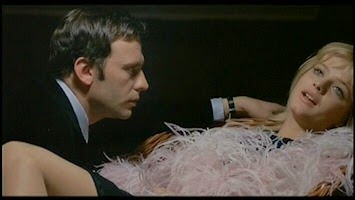Tinto
Brass, 1967
Starring:
Jean-Louis Trintignant, Ewa Aulin, Roberto Bisacco
Bernard
spies an attractive blonde, Jane, in a nightclub, but is warned away from her
because her father recently died in a car accident. He follows her through the
club, only to discover her standing over the body of the club owner. She claims
she is innocent of his murder, but that he was blackmailing her family over a
photo of Jane’s stepmother. Determined to help Jane, she and Bernard run
through London, where they are pursued by a dwarf, the police, armed men, and
more. As the corpses pile up, Bernard realizes that if he doesn’t find the
killer, he could be next.
Cul cuore in gola, which translates to
“With heart pounding” or “His heart in his mouth,” is a rare giallo from Italian
erotica and exploitation director Tinto Brass. Also known as I Am What I Am, Deadly Sweet is based on a novel by Sergio Donati, though much more
emphasis is on the film’s bold style than its plot. Brass uses the unusual
technique of cutting back and forth between color and black-and-white film,
split-screen imagery, quick editing, random inserts of footage from the Vietnam
War, and swingin’ ‘60s costumes and set design. It would make an interesting
double feature with Mario
Bava’s Danger: Diabolik, as both
films share a style borrowed from Italian comic books (Diabolik is of course based on the comic of the same name), and possibly
also borrowed from the previous year’s Tokyo
Drifter, another bold, colorful film that occasionally switches to
black-and-white. Deadly Sweet was allegedly
storyboarded by one of France’s most famous adult comic artists, Guido Crepax.
The
film’s dizzying pop-art sensibilities override the plot at every turn. Bernard
barely works at trying to solve the film’s winding mystery and instead uses it
as a guise to seduce and spend time with Jane. There is little bloodshed, but
plenty of comic and surreal moments in their time dashing across London, trying
to outwit the police, find Jane’s brother – who may have the key to the puzzle –
and evade the murderer themselves. Brass – who wrote the script – does keep you
guessing until the end and manages to distract enough from the plot holes (or
dead zones) that the films stays interesting throughout.
This
Italian-French co-production stars French actor Jean Trintignant, who is a
welcome presence here. Trintignant made his career with art house fare ranging
from And God Created Woman to A Man and a Woman, The Conformist,
Confidentially Yours, Trans-Europe Express, spaghetti western The Great Silence, and Haneke’s recent Amour. He’s certainly on the short list
of actors who have worked with the most number of incredible directors,
including Roger Vadim, Abel Gance, Georges Franju, Costa Gavras, Alain Robbe-Grillet,
Claude Chabrol, Eric Rohmer, Sergio Corbucci, Bertolucci, and so on. He is the
grounding force of Deadly Sweet and
provides with some much needed weight and depth, as the script – which doesn’t
concern itself much with character development – is airy and whimsical. It is
also Bernard’s carefree nature – he doesn’t seem too concerned that Jane might
be a murderer, for instance – that ultimately gets him into trouble.
His
love interest is played by Swedish actress and model Ewa Aulin (Candy, Death Laid an Egg, Death Smiles on a
Murderer), who is (perhaps surprisingly) excellent in the role. Vapid and
cunning in turns, Aulin uses her wide-eyed loveliness to her advantage. There
is one particularly hilarious scene that either references or satirizes Blow Up. Jane and Bernard find
themselves in a photographer’s studio and Jane quickly succumbs to the camera,
modeling for some outrageous photos. This is followed by a fake music video
where Bernard plays drums and then swings through the set, a la Tarzan, before
they consummate their relationship.
I
would be hard-pressed to really describe Deadly
Sweet as a giallo, though it is certainly in a similar territory. The plot
hinges on family dysfunction, a confusing murder mystery, blackmail, and has
some wonderful Eurotrash elements. I have a weakness for films that depict a
ridiculous, Austin Powers-like
version of London in the ‘60s and ‘70s – such as Dracula A.D. 1972 and Psychomania
– and I couldn’t help but succumb to Deadly
Sweet’s charms. Tinto Brass fans will definitely find a lot to love, and
though this is not the director at his most licentious, he is clearly having a
great time experimenting with style and visual techniques.
Surprisingly,
Deadly Sweet is actually available on
a region-free
DVD from Cult Epics, which includes a commentary track from Tinto Brass
himself. It comes recommended, though some horror aficionados will probably be
disappointed by its lack of blood or violence, and its sense of vibrant color
and whimsical comedy. Deadly Sweet is
certainly a product of its time and remains an interesting look at what the
Italian thriller was before Dario Argento bloodied its shores just three years
later with Bird with the Crystal Plumage.
Deadly Sweet has far more in common with the colorful if silly krimi thrillers
to come out of Germany at the same time, which were all set in London, populated
with masked killers, diabolical gangs, intricate subterfuge, seedy nightclubs,
and scantily clad damsels in distress. These films were based on the work of
British writer Edgar Wallace, who interestingly also inspired a few giallo
films.


No comments:
Post a Comment